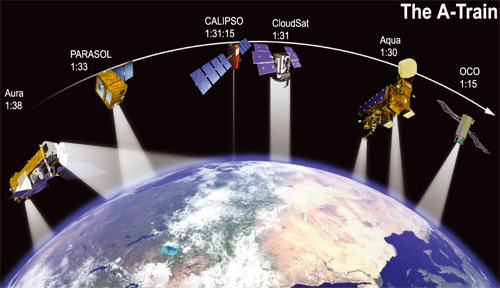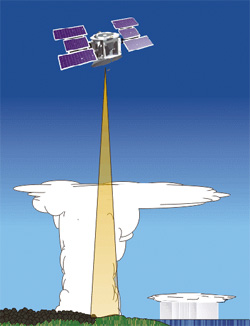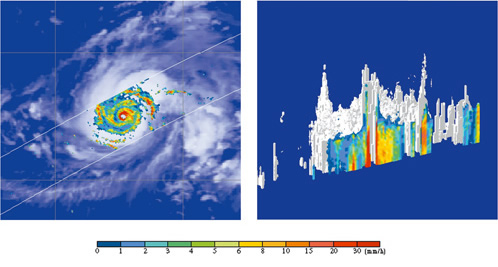Description
These instruments are predominantly based on active microwave radar systems. Cloud profile radars use very short wavelength (mm) radar (typically 94GHz) to detect scattering from non-precipitating cloud droplets or ice particles thereby yielding information on cloud characteristics such as moisture content and base height.
A 94GHz cloud profiling radar has the unique property that it is able to penetrate ice clouds with negligible attenuation and provide a range-gated profile of cloud characteristics.
Rain radars use centimetric radiation to detect backscatter from water drops and ice particles in precipitating clouds, and to measure the vertical profile of such particles. One of the key challenges with rain radars is suppressing the return from the Earth’s surface clutter, which is inevitably much stronger than the rain echo. Recent instruments however, can map the 3-D distribution of precipitating water and ice in a relatively narrow swath (around 200km) along the track of a low altitude satellite and thereby infer more precise estimates of instantaneous rainfall.
The Precipitation Radar (PR) on the Tropical Rainfall Measuring Mission launched in 1997 (with the mission just recently terminating in early 2005) was the first radar in space with the capability to measure rainfall. PR provided three-dimensional maps of storm structure, and invaluable information on the intensity and distribution of rain, rain type, and storm depth.
To date, there has been no cloud radar flown in space, but advanced instruments on planned missions (eg NASA’s Cloudsat, Mar 2005) will use advanced radar to ‘slice’ through clouds to see their vertical structure, providing a completely new observational capability from space. These instruments will be the first to study clouds on a global basis, and to look at their structure, composition and effects. From 2009, the Global Precipitation Measurement (GPM) mission - an international co-operative programme - will provide more frequent and complete sampling of the Earth’s precipitation using a constellation of satellites.
Applications
Measurements from cloud radar will give information on cloud type and amount, and more importantly on cloud profile (currently not measured), information which is required both for improving numerical weather prediction and for climate studies. Scientists believe that some of the main uncertainties in climate model simulation are due to the difficulties in adequately representing clouds and their radiative properties. Satellite observations are planned to address this issue.
TRMM has demonstrated that spaceborne rain radars can provide a unique source of information on liquid water and precipitation rate - since the ground based rain radars used at present have limited coverage over the oceans. The global precipitation datasets derived from TRMM have proven to be valuable tools for climatologists. Information on tropical rainfall and extreme events such as hurricanes is of particular importance, since more than two thirds of global rainfall is in the Tropics, and is a primary driver of global atmospheric circulation.
The gap between termination of the TRMM mission (early 2005) - and availability of the new information anticipated from GPM (no earlier than 2009) is of concern to scientists studying the Earth’s global water cycle.
 CloudSat will fly in orbital formation as part of a constellation of satellites including Aqua, Aura (multi-sensor platforms that are a part of NASA's Earth Observing System), CALIPSO (a NASA-CNES lidar satellite), PARASOL (a CNES satellite carrying a polarimeter), and OCO (NASA’s CO2 measurement mission) |
 The CloudSat radar will penetrate into and through clouds, yielding a new capability that fills a critical gap in existing and planned observations |
The Precipitation Radar on TRMM provided new insights into the 3-D rain structure of storms |
| Current & planned instruments Cloud sensor CPR CPR (Cloudsat) DPR IGPM rain radar |
| CPR (Cloudsat): cloudsat.atmos.colostate.edu/cs4a.html Precipitation radar: trmm.gsfc.nasa.gov/overview_dir/pr.html GPM: gpm.gsfc.nasa.gov/index.html |
